Abstract
The aim was to study, in a population-based cohort design, whether first-born sons run a higher risk of testicular cancer than later born sons; to investigate whether this difference in risk was affected by birth cohort, age of the son, maternal age, interval to previous delivery and other reproductive factors; and, finally, to evaluate to what extent changes in women's parity over time might explain the increasing incidence of testicular cancer. By using data from the Civil Registration System, a database was established of all women born in Denmark since 1935 and all their children alive in 1968 or born later. Sons with testicular cancer were identified in the Danish Cancer Registry. Among 1015994 sons followed for 15981 967 person-years, 626 developed testicular cancer (443 non-seminomas, 183 seminomas). Later born sons had a decreased risk of testicular cancer (RR = 0.80, 95% CI = 0.67-0.95) compared with first-born sons. The RR was 0.79 (95% CI = 0.64-0.98) for non-seminomas and 0.81 (95% CI = 0.58-1.13) for seminomas. There was no association between testicular cancer risk and overall parity of the mother, maternal or paternal age at the birth of the son, or maternal age at first birth. The decreased risk of testicular cancer among later born sons was not modified by age, birth cohort, interval to the previous birth, sex of the first-born child, or maternal age at birth of the son or at first birth. The increased proportion of first-borns from birth cohort 1946 to birth cohort 1969 only explained around 3% of an approximated two-fold increase in incidence between the cohorts. Our data document a distinctly higher risk of testicular cancer in first-born compared with later born sons and suggest that the most likely explanation should be sought among exposures in utero. The increase in the proportion of first-borns in the population has only contributed marginally to the increase in testicular cancer incidence.
Full text
PDF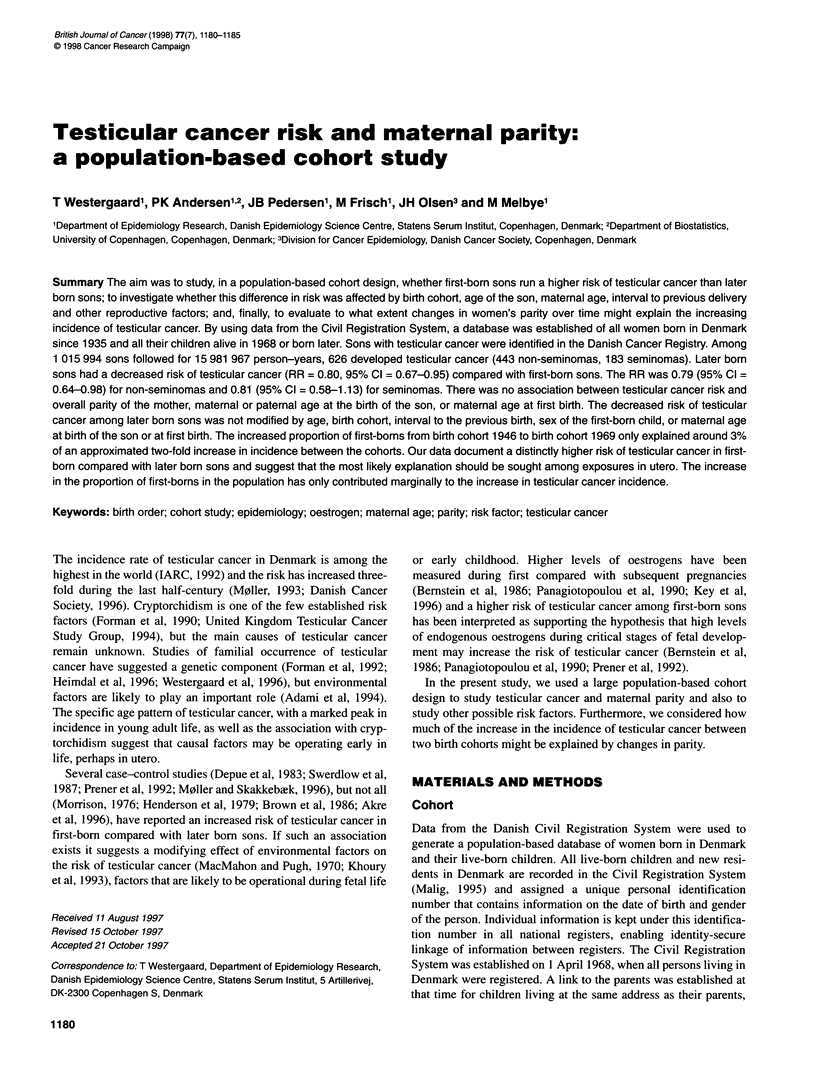
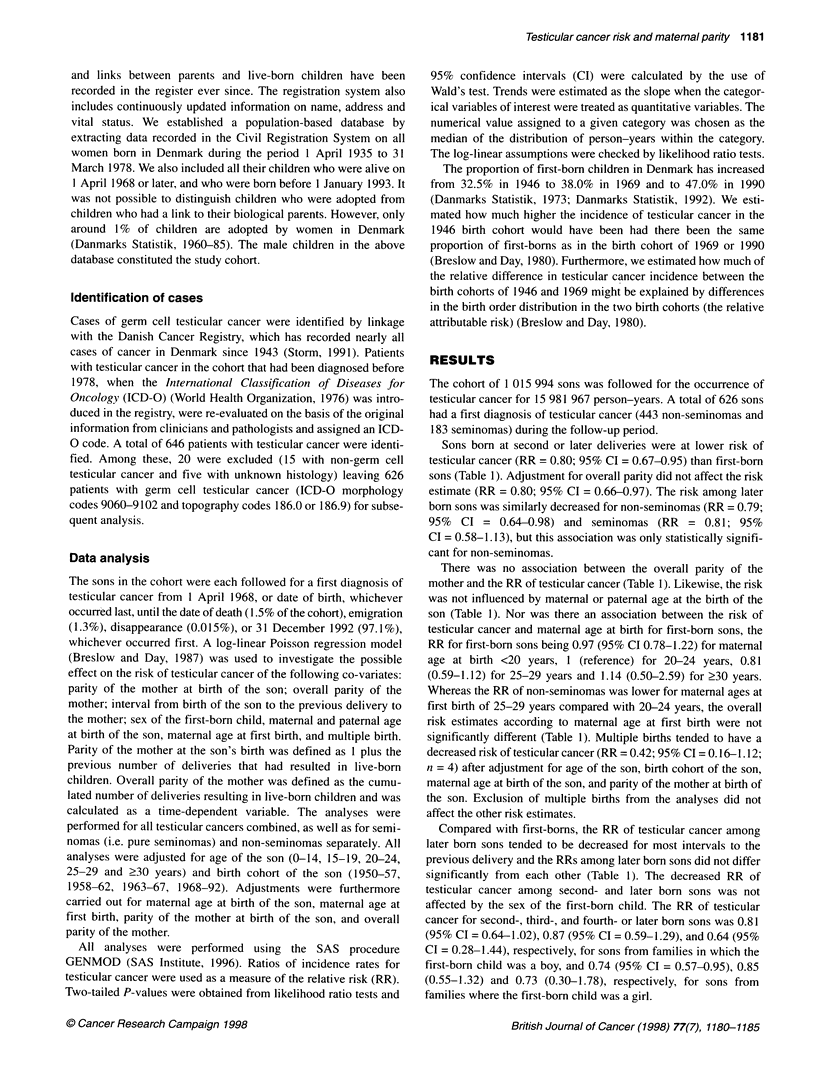
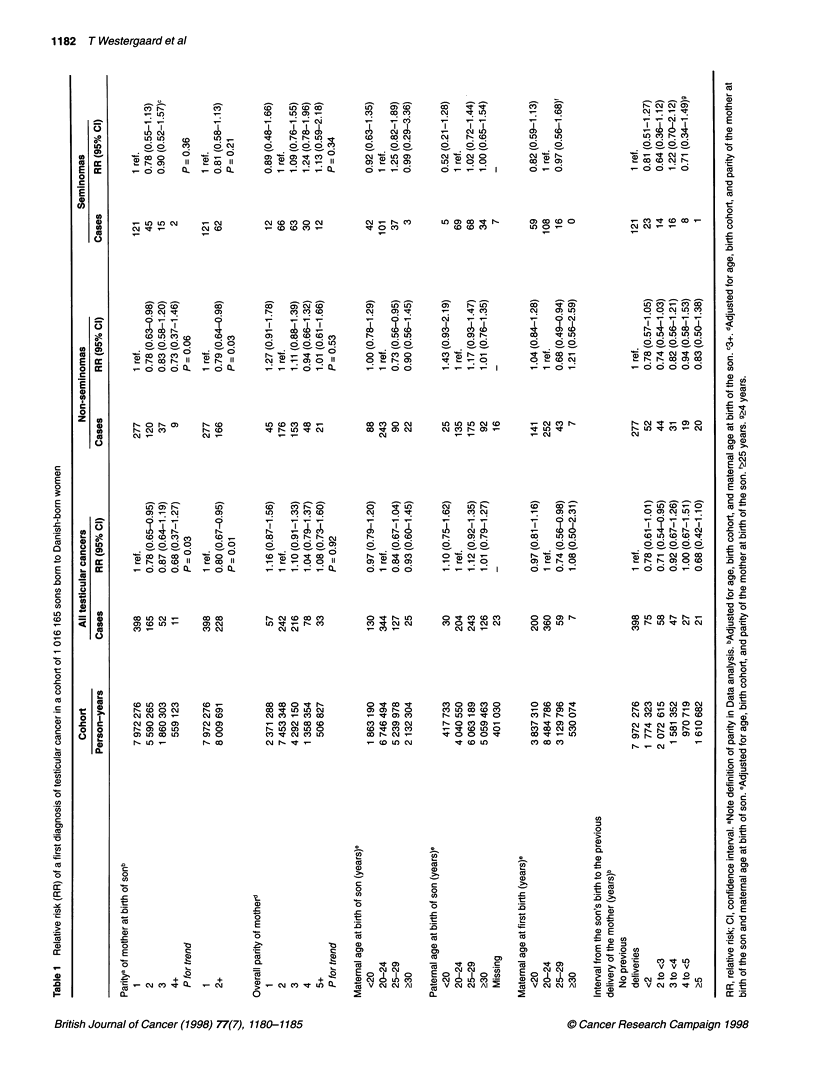
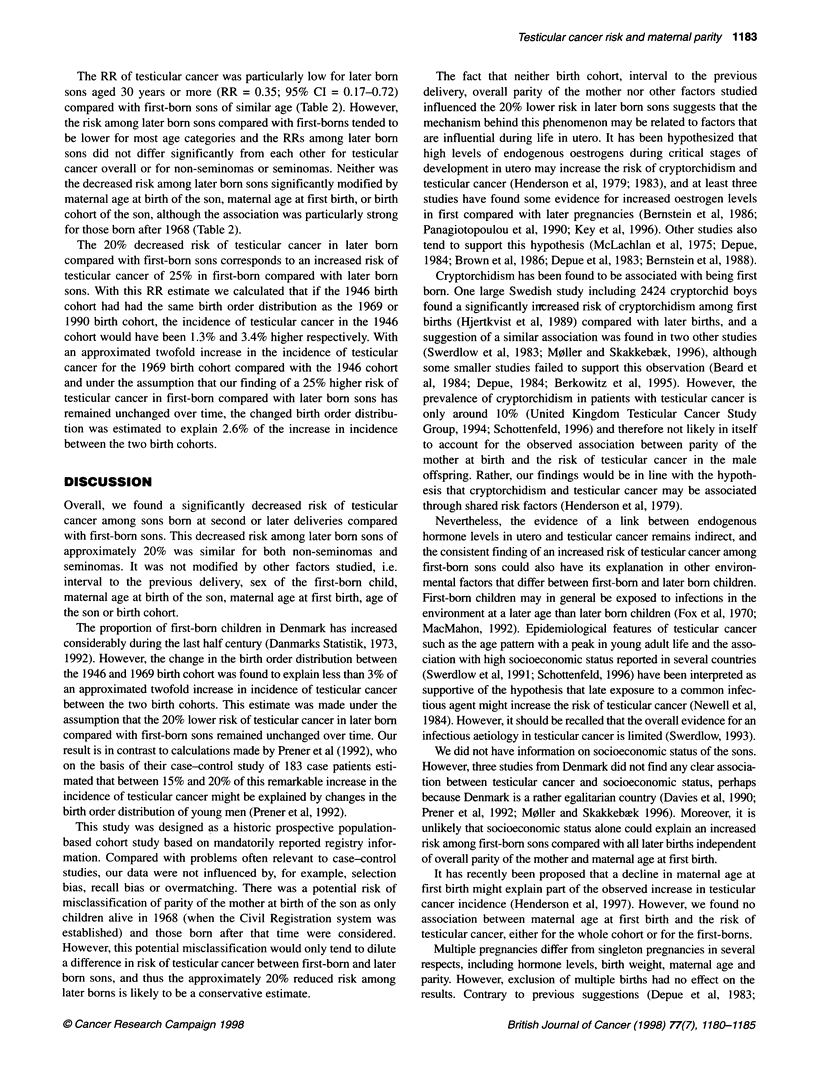
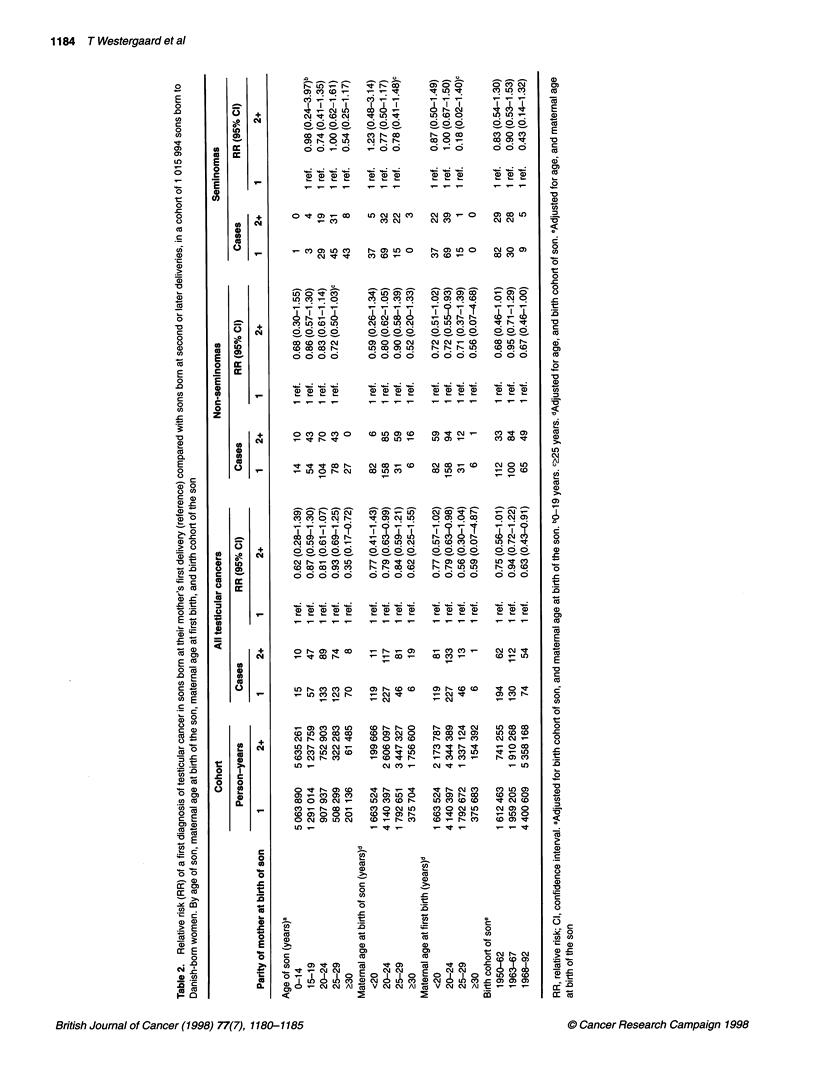
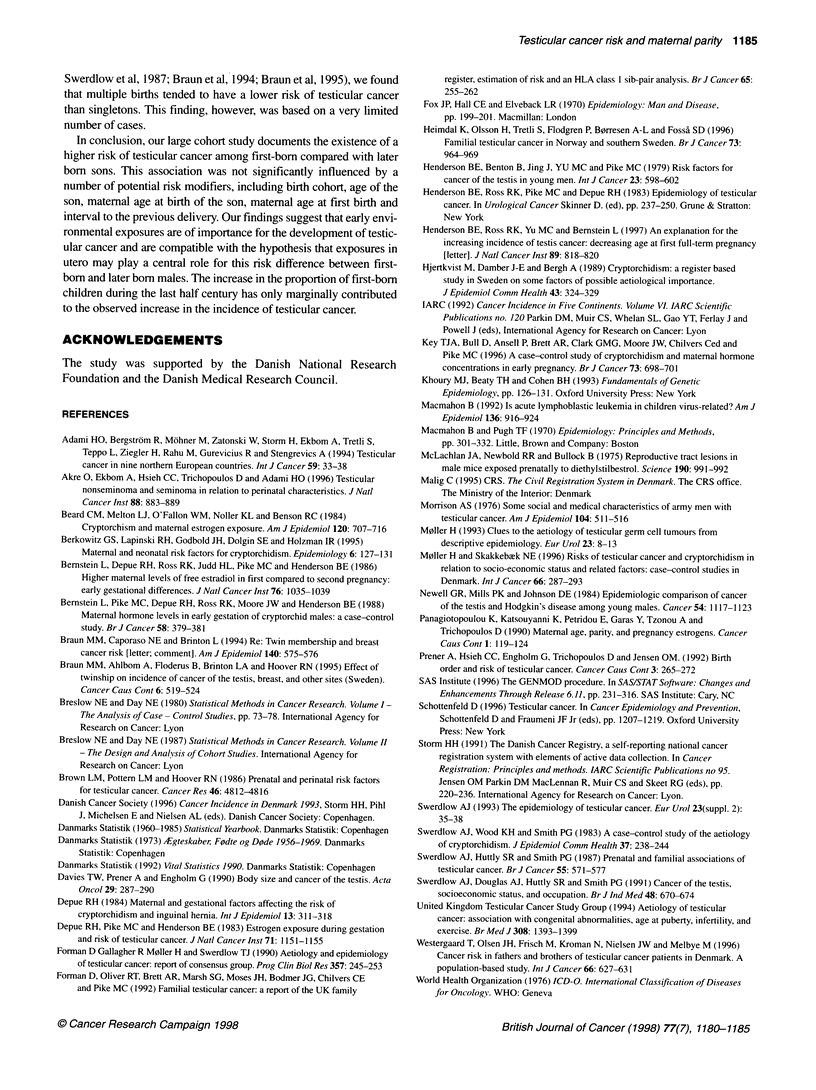
Selected References
These references are in PubMed. This may not be the complete list of references from this article.
- Adami H. O., Bergström R., Möhner M., Zatoński W., Storm H., Ekbom A., Tretli S., Teppo L., Ziegler H., Rahu M. Testicular cancer in nine northern European countries. Int J Cancer. 1994 Oct 1;59(1):33–38. doi: 10.1002/ijc.2910590108. [DOI] [PubMed] [Google Scholar]
- Akre O., Ekbom A., Hsieh C. C., Trichopoulos D., Adami H. O. Testicular nonseminoma and seminoma in relation to perinatal characteristics. J Natl Cancer Inst. 1996 Jul 3;88(13):883–889. doi: 10.1093/jnci/88.13.883. [DOI] [PubMed] [Google Scholar]
- Beard C. M., Melton L. J., 3rd, O'Fallon W. M., Noller K. L., Benson R. C. Cryptorchism and maternal estrogen exposure. Am J Epidemiol. 1984 Nov;120(5):707–716. doi: 10.1093/oxfordjournals.aje.a113938. [DOI] [PubMed] [Google Scholar]
- Berkowitz G. S., Lapinski R. H., Godbold J. H., Dolgin S. E., Holzman I. R. Maternal and neonatal risk factors for cryptorchidism. Epidemiology. 1995 Mar;6(2):127–131. doi: 10.1097/00001648-199503000-00007. [DOI] [PubMed] [Google Scholar]
- Bernstein L., Depue R. H., Ross R. K., Judd H. L., Pike M. C., Henderson B. E. Higher maternal levels of free estradiol in first compared to second pregnancy: early gestational differences. J Natl Cancer Inst. 1986 Jun;76(6):1035–1039. [PubMed] [Google Scholar]
- Bernstein L., Pike M. C., Depue R. H., Ross R. K., Moore J. W., Henderson B. E. Maternal hormone levels in early gestation of cryptorchid males: a case-control study. Br J Cancer. 1988 Sep;58(3):379–381. doi: 10.1038/bjc.1988.223. [DOI] [PMC free article] [PubMed] [Google Scholar]
- Braun M. M., Ahlbom A., Floderus B., Brinton L. A., Hoover R. N. Effect of twinship on incidence of cancer of the testis, breast, and other sites (Sweden). Cancer Causes Control. 1995 Nov;6(6):519–524. doi: 10.1007/BF00054160. [DOI] [PubMed] [Google Scholar]
- Braun M. M., Caporaso N. E., Brinton L. Re: "Twin membership and breast cancer risk". Am J Epidemiol. 1994 Sep 15;140(6):575–576. doi: 10.1093/oxfordjournals.aje.a117286. [DOI] [PubMed] [Google Scholar]
- Brown L. M., Pottern L. M., Hoover R. N. Prenatal and perinatal risk factors for testicular cancer. Cancer Res. 1986 Sep;46(9):4812–4816. [PubMed] [Google Scholar]
- Davies T. W., Prener A., Engholm G. Body size and cancer of the testis. Acta Oncol. 1990;29(3):287–290. doi: 10.3109/02841869009089999. [DOI] [PubMed] [Google Scholar]
- Depue R. H. Maternal and gestational factors affecting the risk of cryptorchidism and inguinal hernia. Int J Epidemiol. 1984 Sep;13(3):311–318. doi: 10.1093/ije/13.3.311. [DOI] [PubMed] [Google Scholar]
- Depue R. H., Pike M. C., Henderson B. E. Estrogen exposure during gestation and risk of testicular cancer. J Natl Cancer Inst. 1983 Dec;71(6):1151–1155. [PubMed] [Google Scholar]
- Forman D., Gallagher R., Møller H., Swerdlow T. J. Aetiology and epidemiology of testicular cancer: report of consensus group. Prog Clin Biol Res. 1990;357:245–253. [PubMed] [Google Scholar]
- Forman D., Oliver R. T., Brett A. R., Marsh S. G., Moses J. H., Bodmer J. G., Chilvers C. E., Pike M. C. Familial testicular cancer: a report of the UK family register, estimation of risk and an HLA class 1 sib-pair analysis. Br J Cancer. 1992 Feb;65(2):255–262. doi: 10.1038/bjc.1992.51. [DOI] [PMC free article] [PubMed] [Google Scholar]
- Heimdal K., Olsson H., Tretli S., Flodgren P., Børresen A. L., Fossa S. D. Familial testicular cancer in Norway and southern Sweden. Br J Cancer. 1996 Apr;73(7):964–969. doi: 10.1038/bjc.1996.173. [DOI] [PMC free article] [PubMed] [Google Scholar]
- Henderson B. E., Benton B., Jing J., Yu M. C., Pike M. C. Risk factors for cancer of the testis in young men. Int J Cancer. 1979 May 15;23(5):598–602. doi: 10.1002/ijc.2910230503. [DOI] [PubMed] [Google Scholar]
- Henderson B. E., Ross R. K., Yu M. C., Bernstein L. An explanation for the increasing incidence of testis cancer: decreasing age at first full-term pregnancy. J Natl Cancer Inst. 1997 Jun 4;89(11):818–820. doi: 10.1093/jnci/89.11.818. [DOI] [PubMed] [Google Scholar]
- Hjertkvist M., Damber J. E., Bergh A. Cryptorchidism: a registry based study in Sweden on some factors of possible aetiological importance. J Epidemiol Community Health. 1989 Dec;43(4):324–329. doi: 10.1136/jech.43.4.324. [DOI] [PMC free article] [PubMed] [Google Scholar]
- Key T. J., Bull D., Ansell P., Brett A. R., Clark G. M., Moore J. W., Chilvers C. E., Pike M. C. A case-control study of cryptorchidism and maternal hormone concentrations in early pregnancy. Br J Cancer. 1996 Mar;73(5):698–701. doi: 10.1038/bjc.1996.121. [DOI] [PMC free article] [PubMed] [Google Scholar]
- MacMahon B. Is acute lymphoblastic leukemia in children virus-related? Am J Epidemiol. 1992 Oct 15;136(8):916–924. doi: 10.1093/oxfordjournals.aje.a116564. [DOI] [PubMed] [Google Scholar]
- McLachlan J. A., Newbold R. R., Bullock B. Reproductive tract lesions in male mice exposed prenatally to diethylstilbestrol. Science. 1975 Dec 5;190(4218):991–992. doi: 10.1126/science.242076. [DOI] [PubMed] [Google Scholar]
- Morrison A. S. Some social and medical characteristics of Army men with testicular cancer. Am J Epidemiol. 1976 Nov;104(5):511–516. doi: 10.1093/oxfordjournals.aje.a112323. [DOI] [PubMed] [Google Scholar]
- Møller H., Skakkebaek N. E. Risks of testicular cancer and cryptorchidism in relation to socio-economic status and related factors: case-control studies in Denmark. Int J Cancer. 1996 May 3;66(3):287–293. doi: 10.1002/(SICI)1097-0215(19960503)66:3<287::AID-IJC2>3.0.CO;2-V. [DOI] [PubMed] [Google Scholar]
- Newell G. R., Mills P. K., Johnson D. E. Epidemiologic comparison of cancer of the testis and Hodgkin's disease among young males. Cancer. 1984 Sep 15;54(6):1117–1123. doi: 10.1002/1097-0142(19840915)54:6<1117::aid-cncr2820540633>3.0.co;2-y. [DOI] [PubMed] [Google Scholar]
- Panagiotopoulou K., Katsouyanni K., Petridou E., Garas Y., Tzonou A., Trichopoulos D. Maternal age, parity, and pregnancy estrogens. Cancer Causes Control. 1990 Sep;1(2):119–124. doi: 10.1007/BF00053162. [DOI] [PubMed] [Google Scholar]
- Prener A., Hsieh C. C., Engholm G., Trichopoulos D., Jensen O. M. Birth order and risk of testicular cancer. Cancer Causes Control. 1992 May;3(3):265–272. doi: 10.1007/BF00124260. [DOI] [PubMed] [Google Scholar]
- Swerdlow A. J., Douglas A. J., Huttly S. R., Smith P. G. Cancer of the testis, socioeconomic status, and occupation. Br J Ind Med. 1991 Oct;48(10):670–674. doi: 10.1136/oem.48.10.670. [DOI] [PMC free article] [PubMed] [Google Scholar]
- Swerdlow A. J., Huttly S. R., Smith P. G. Prenatal and familial associations of testicular cancer. Br J Cancer. 1987 May;55(5):571–577. doi: 10.1038/bjc.1987.116. [DOI] [PMC free article] [PubMed] [Google Scholar]
- Swerdlow A. J. The epidemiology of testicular cancer. Eur Urol. 1993;23 (Suppl 2):35–38. doi: 10.1159/000474700. [DOI] [PubMed] [Google Scholar]
- Swerdlow A. J., Wood K. H., Smith P. G. A case-control study of the aetiology of cryptorchidism. J Epidemiol Community Health. 1983 Sep;37(3):238–244. doi: 10.1136/jech.37.3.238. [DOI] [PMC free article] [PubMed] [Google Scholar]
- Westergaard T., Olsen J. H., Frisch M., Kroman N., Nielsen J. W., Melbye M. Cancer risk in fathers and brothers of testicular cancer patients in Denmark. A population-based study. Int J Cancer. 1996 May 29;66(5):627–631. doi: 10.1002/(SICI)1097-0215(19960529)66:5<627::AID-IJC8>3.0.CO;2-V. [DOI] [PubMed] [Google Scholar]


